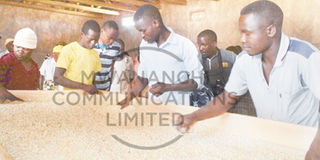Govt allays fears after food poison catastrophe

Farmers in Mufindi District, Iringa Region, inspect stored maize on Tuesday. The government told The Citizen yesterday that it was taking measures to get rid of contaminated cereals that have killed 14 people and hospitalised dozens in Dodoma and Manyara regions. PHOTO | HAKIM MWAFONGO
What you need to know:
- The contaminated cereals that killed 14 people came directly from household farms in the affected regions of Dodoma and Manyara, and were not sold through the usual trading channels, the Minister for Health, Community Development, Gender, Children and the Elderly, Ms Ummy Mwalimu, told The Citizen.
Dar es Salaam. The cereals that were contaminated by the deadly aflatoxin poison were from household farms, not cereal markets and other supply chains, the government has said.
The contaminated cereals that killed 14 people came directly from household farms in the affected regions of Dodoma and Manyara, and were not sold through the usual trading channels, the Minister for Health, Community Development, Gender, Children and the Elderly, Ms Ummy Mwalimu, told The Citizen.
She allayed fears of widespread contamination, saying people in the two regions had been cautioned against consuming the cereals, adding that the government was in the process of “mopping up” poisoned food in the affected districts.
“The contaminated maize is still within households, and the government has advised people (in the affected areas) to stop using it. We are taking concrete measures to ensure that there are no new cases of food poisoning,’’ Ms Mwalimu said.
Aflatoxin is a naturally occurring poison produced by a type of fungus known as Aspergillus flavus.
People may be directly exposed to it by consuming contaminated crops or indirectly through meat products or milk from livestock fed with contaminated grains.
To control aflatoxins in farms, an independent pharmacist based in Dar es Salaam, Dr Sajjad Fazel, suggests that crops can be protected by deliberately introducing a non-toxic form of Aspergillus fungus known as aflasafe.
“This (alflasafe) causes competitive inhibition between the two strains—the toxic and non-toxic one–in which case the toxic strain eventually gets displaced from the field,” he said.
Reports said yesterday that the National Food Reserve Agency had distributed 100 tonnes of food among victims of food poisoning in Dodoma Region.
The Director of Disaster Management in the Prime Minister’s Office, Mr Mbazi Msuya, told The Citizen in Dodoma that his office, in collaboration with the Tanzania Food and Drugs Authority, would carry out a survey to establish the exact number of people affected.
Until yesterday, the official number of people affected was 54. However, two more people were rushed to hospital in Kondoa District yesterday, according to Health ministry sources.
The crisis was first reported on June 13 in Chemba District, Dodoma Region. It was reported that a family of nine in Mwaikisabe Village was affected before more people fell ill in neighbouring areas.
Ms Mwalimu said on Monday that the majority of the people affected by aflatoxicosis died of liver failure.
The US-based Center for Disease Control (CDC) has isolated the most poisonous and cancer-causing substance known as Aflatoxin B1 from blood samples taken from victims. This type of aflatoxin damages the liver, according to medical sources.




